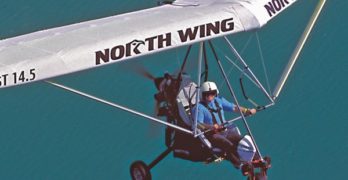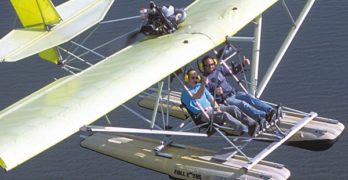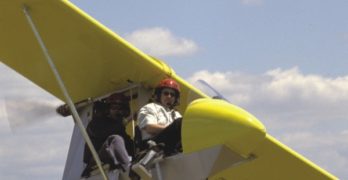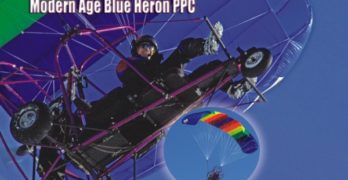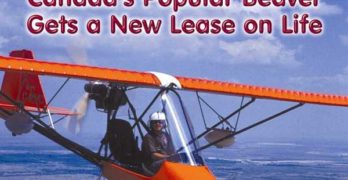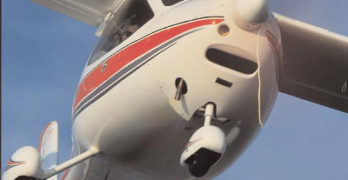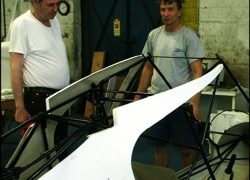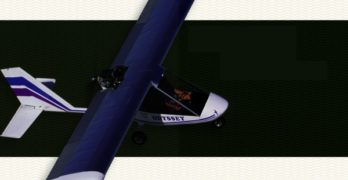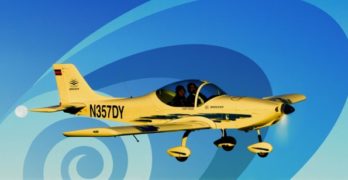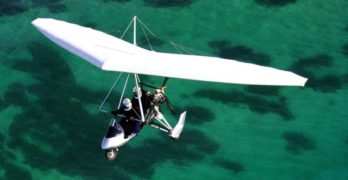A couple of years ago, TC’s Trikes owner TC Blyth and North Wing owner Kamron Blevins joined forces in a cooperative arrangement. TC’s Trikes would buy wings from North Wing (rather than continue to make their own), and could better represent North Wing on the Eastern Seaboard. North Wing, headquartered in the northwestern state of Washington, is far from TC’s Trikes’ Tennessee home. It seemed a marriage of convenience and more.
Blyth has been particularly active in training and introductory flight lessons. He’s done many thousands of them at his location near a top Tennessee tourist and outdoorsmen attraction – the Ocoee River, popular for white water rafting, kayaking, and other sports. Blyth has been focused on meeting this need with his own brand of trikes, and all his experience gave him something clear and viable to add to the expertise of North Wing.
North Wing has risen to the top of the U.S.
Search Results for : Four stroke and ultralight
Not finding exactly what you expected? Try our advanced search option.
Select a manufacturer to go straight to all our content about that manufacturer.
Select an aircraft model to go straight to all our content about that model.
Float-Flying the M-Squared Sprint 1000
“Air in your hair!
Space on your face! A breeze on your knees!” A former colleague of mine used to repeat this short mantra to illustrate the joy of open-cockpit flying. It was catchy and engaging and his customers liked it.
With 15 Light-Sport Aircraft now possessing their FAA Special Light-Sport Aircraft (SLSA) airworthiness certificates, not a single one is open cockpit, though the IndUS Thorpedo, Legend Cub, and Tecnam Sierra can enjoy partially open cockpits.
Special Light-Sport Aircraft will eventually add more of this genre of light aircraft but one of the beauties of FAA’s new regulation is that it does not eliminate two previous categories: Amateur-built 51% kits or Part 103-compliant ultralights.
With 21¼4 years left before operators of 2-seat 496-pound empty weight ultralight exempt trainers must register in FAA’s new Light-Sport Aircraft category, and with 41¼4 years left while these machines can be used for compensated training flights, the segment still has lots of life remaining.
The Lil’ Breezy B-Model
Open-Cockpit 2-seater
ust when you felt as though Light-Sport Aircraft (LSA) was the only segment of aviation getting any press, along comes a flying machine that harks back to the early days of ultralighting but with a distinctive fuselage construction and composite wings.
Just when it seemed like every new LSA had to be enclosed, four-stroke-powered, fast, and have leather seats, along comes a new open-cockpit, mile-a-minute airplane that can easily carry two people on the power of a 50-hp Rotax 503. The leather is on your flight jacket.
The Lil’ Breezy B can weigh 350 pounds empty, fly at 60 mph, and sell for $12,500 (for all parts plus engine/prop but not your assembly labor). In my experience that sounds like an ultralight. Born in the new millennium, the Lil’ Breezy B is a modern ultralight.
Before we go fly, let’s examine the machine and talk to its developer, Jack Harper.
Modern Age Blue Heron PPC
Here we are
in the spring of 2006 wondering about the future of ultralights in an age seemingly gone crazy about Sport Pilot/Light-Sport Aircraft (SP/LSA). For powered parachute manufacturer Heldeberg Designs, the answer is easy. They’ve been preparing for the LSA program for a long time. How will they fare?
Today, we have a great divide* between ultralight pilots on one side and LSA enthusiasts on the other. The ultralight pilots see rather modest benefit to becoming Sport Pilots flying ultralights converted to Experimental Light-Sport Aircraft (ELSA). One major downside is that most such aircraft will have to settle a sales tax bill (states become aware of the aircraft when owners obtain their N-numbers). Other limitations include not flying over 10,000 feet or being required to perform an annual condition inspection. And this is by no means a complete gripes list.
The LSA contingent responds, “That ship has sailed. SP/LSA is here.
Beaver RX-550
Perhaps the most famous ultralight to come out of Canada is the Beaver. With a reported 2,200 units flying since the early 1980s, this is one of the most successful light aircraft ever. However, due to missteps by companies that previously manufactured the brand, this popular ultralight was nearly lost from the ultralight aviation landscape. Were it not for the Aircraft Sales and Parts (ASAP) company and the Holomis family, you might not have this choice today.
Originally the Beaver RX-550 came from a company called Spectrum Aircraft. A company reorganization left the ultralight in the hands of a company named Beaver RX Enterprises. Both these business names disappeared and today the ASAP brand carries the Beaver into the sky.
In 1993, a couple years after our last report on the Beaver1, the old company closed its doors and effectively stranded thousands of Beaver ultralight owners and all the dealerships that sold them.
Flight Design CT2K
A Bold Yet Efficient Euro-Designed Light-Sport Aircraft
Flightstar imports the CT2K in anticipation of the light-sport aircraft rule.
As FAA’s proposed light-sport aircraft
rule looms ever closer, one
of the first aircraft that will likely
fit the field and be recognized by American
pilots is Germany’s CT. For the U.S.
market, and with a nod to the new millennium,
producer Flight Designs has
renamed the model as the CT2K.
“CT” stands for Composite Twoseater.
It is certainly not alone in being
“white, glass, and built overseas,” a
theme that emerged at EAA AirVenture
Oshkosh 2002. But the design was a
leader in the move from tube-and-rag
ultralights to the modern microlights of
Europe. And it distinguishes itself in a
number of ways that we’ll explore in
this review.
My experiences flying the CT on two
occasions were both with Europeanbased
check pilots. The most recent
opportunity was with Allistair Wilson,
formerly a major with the Royal Irish
Regiment in Northern Ireland.
Manufacturing Earthstar Aircraft in Israel
Avicom, Earthstar’s new partner in building Odysseys and Gull 2000s, has been
an importer and distributor of American-made aircraft in Israel for several years,
but taking on the manufacturing of an aircraft is a different enterprise. Still,
Avicom principles Miki “Mike” Raviv and Abraham “Kim” Kimchi understood that
Mark’s designs needed and deserved better manufacturing capability. They will
accomplish that goal through a partnership with Kanfit Ltd., a well-established
aerospace parts and systems manufacturer in Israel.
In May 2005, Mark and his wife,
Leslie, visited Israel to evaluate Avicom
and Kanfit. After a week of visits and
meetings, the American couple took
home a Technology Transfer Agreement
for review.
On July 18, 2005, the contracts were
signed, giving Avicom the manufacturing
and worldwide marketing rights to
the Odyssey and Gull 2000.
In late July, Mike and Kim flew with
Mark from Earthstar’s headquarters
in Santa Margarita, California, to EAA
AirVenture Oshkosh 2005 to become better
acquainted with the aircraft and the
business.
Earthstar’s Odyssey Continues
After flying many ultralight and light-sport aircraft, I’ve found the handling
and performance characteristics of Earthstar Aircraft’s machines
suit me as well as or better than any others. With that said, let me
tell you about some significant changes that may thrust this small
California company into the mainstream of light-sport aviation.
Mark Beierle created the Thunder Gull series of ultralights after working in the
aerospace industry … and being discouraged with the ultralights available in the
early 1980s. He was interested in perfecting his designs, so his priority was not producing
numerous units. Instead, he wanted to produce an aircraft with classic flying
characteristics. Customer response to his machines was excellent, but delivery
often stretched into months, even years. To own a prized Earthstar model, you had
to have patience. This situation gave another company, Titan Aircraft, a chance to
build a similar design, the Titan Tornado, and its business took off while Earthstar
remained deliberately small.
Breezing Along
Like American
ultralights, European
microlights have paved the way
to a new breed of aircraft for European
fliers. Residents of the European community
don’t have the sport pilot/light-sport aircraft
(SP/LSA) rule, but they know how to build the planes
that serve the market.
Comco-Ikarus is one of Germany’s most
established microlight builders. After a
long and successful run with its C22
and C42 airplanes, the company,
based in Hohentengen in
southwest Germany, is
ready to run in LSA
circles with its
new Breezer.
Compared to the C22 and C42,
which is still being sold in Germany and
the United States, the Breezer is clearly
an original design. The Breezer has a
metal wing and tail, whereas the C42
has a fiberglass fuselage and its wings
are constructed of aluminum tubes and
covered with an advanced sewn textile
called GT-Foil, a Kevlar-based material.
The Breezer is a low-wing airplane,
whereas the C42 is a high-wing; the
C42 is strut-braced, while the Breezer
is cantilevered.
AirBorne’s XT 912 Trike
Racing to be the first weight-shift S-LSA
In early January, the FAA accepted the ASTM consensus standards
for weight-shift control (WSC) aircraft, commonly known as trikes.
The agency’s action paved the way for trike manufacturers to certificate
ready-to-fly machines as special light-sport aircraft (S-LSA). Now,
the race is on to see which company will be the first to complete the
steps necessary to show compliance with the newly approved standards.
One company in the running is
AirBorne Australia, and it is already
accepting orders for its S-LSA model,
the AirBorne XT 912. How can it be so
confident this model will comply? Its
machines already meet Australia’s tough
certification standards, so the effort is
primarily one of paperwork. (Though
preparing documents to the FAA’s precise
requirements is no trivial task, as
anyone who has tried to correctly fill
out the sport pilot certificate application
knows.) Interestingly, Australia is
one of two nations-Colombia is the
other-that have accepted the sport
pilot/light-sport aircraft (SP/LSA) rule
as part of their national program.
- « Previous Page
- 1
- …
- 9
- 10
- 11
- 12
- 13
- …
- 17
- Next Page »


